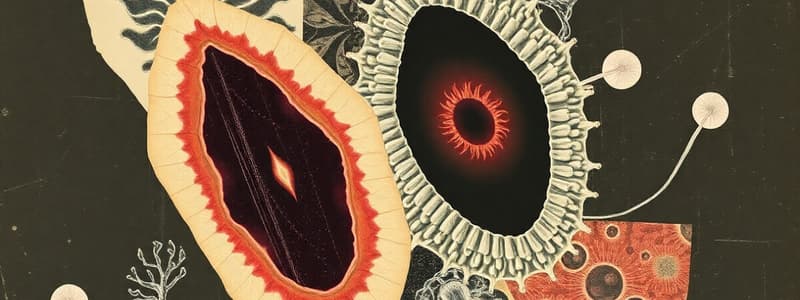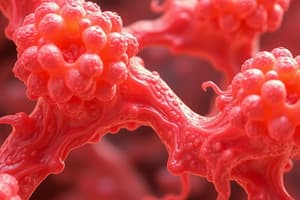Podcast
Questions and Answers
Which characteristic distinguishes endocrine glands from other gland types?
Which characteristic distinguishes endocrine glands from other gland types?
- Presence of myoepithelial cells
- Secretion via ducts
- Production of mucous secretions
- Lack of myoepithelial cells (correct)
Epithelial cells in complex glands, such as the liver, are typically part of a rapidly renewing cell population.
Epithelial cells in complex glands, such as the liver, are typically part of a rapidly renewing cell population.
False (B)
What is the primary mechanism by which steroid hormones are released from endocrine cells?
What is the primary mechanism by which steroid hormones are released from endocrine cells?
diffusion through the cell membrane
The replacement of epithelial cells in continuously renewing populations is primarily due to the mitotic activity of self-maintaining adult ______ cells.
The replacement of epithelial cells in continuously renewing populations is primarily due to the mitotic activity of self-maintaining adult ______ cells.
Match the following gland types with their primary secretion characteristics:
Match the following gland types with their primary secretion characteristics:
What cellular feature is used to name types of epithelia?
What cellular feature is used to name types of epithelia?
Proteins are released from endocrine glands via diffusion through the cell membrane.
Proteins are released from endocrine glands via diffusion through the cell membrane.
In epithelia with complex glands, what stimulates cell division?
In epithelia with complex glands, what stimulates cell division?
What is the function of myoepithelial cells in exocrine glands?
What is the function of myoepithelial cells in exocrine glands?
The key difference between endocrine and exocrine glands is that endocrine glands lack ______ cells.
The key difference between endocrine and exocrine glands is that endocrine glands lack ______ cells.
Which of the following is NOT a primary function of secretory cells?
Which of the following is NOT a primary function of secretory cells?
Goblet cells are an example of multicellular exocrine glands.
Goblet cells are an example of multicellular exocrine glands.
What is the primary structural difference between a simple tubular and a coiled tubular exocrine gland?
What is the primary structural difference between a simple tubular and a coiled tubular exocrine gland?
Acne vulgaris is often a result of blocked ducts in __________ glands due to excessive sebum production.
Acne vulgaris is often a result of blocked ducts in __________ glands due to excessive sebum production.
Match the exocrine gland secretion method with its description:
Match the exocrine gland secretion method with its description:
Which type of exocrine gland secretion involves the release of secretory products via exocytosis without causing damage to the cell?
Which type of exocrine gland secretion involves the release of secretory products via exocytosis without causing damage to the cell?
Endocrine glands secrete their products directly onto an epithelial surface.
Endocrine glands secrete their products directly onto an epithelial surface.
What is the primary difference between tubular and alveolar exocrine glands based on their structure?
What is the primary difference between tubular and alveolar exocrine glands based on their structure?
Which of the following structural classifications describes a gland that has a single unbranched duct with multiple secretory units?
Which of the following structural classifications describes a gland that has a single unbranched duct with multiple secretory units?
In __________ secretion, the apical portion of the cell containing the secretory product is pinched off and released.
In __________ secretion, the apical portion of the cell containing the secretory product is pinched off and released.
Flashcards
Merocrine secretion
Merocrine secretion
Release secretions via exocytosis; cells survive.
Holocrine secretion
Holocrine secretion
Accumulate secretions, then cell ruptures to release product.
Apocrine secretion
Apocrine secretion
Release apical portion of cell with secretions.
Mucous glands
Mucous glands
Signup and view all the flashcards
Serous glands
Serous glands
Signup and view all the flashcards
Seromucous glands
Seromucous glands
Signup and view all the flashcards
Myoepithelial cells
Myoepithelial cells
Signup and view all the flashcards
Endocrine secretion
Endocrine secretion
Signup and view all the flashcards
Epithelial renewal
Epithelial renewal
Signup and view all the flashcards
Naming types of epithelia
Naming types of epithelia
Signup and view all the flashcards
Secretory Epithelia
Secretory Epithelia
Signup and view all the flashcards
Function of Secretory Cells
Function of Secretory Cells
Signup and view all the flashcards
Unicellular Gland
Unicellular Gland
Signup and view all the flashcards
Exocrine Glands
Exocrine Glands
Signup and view all the flashcards
Exocrine Gland Classification (Structure)
Exocrine Gland Classification (Structure)
Signup and view all the flashcards
Exocrine vs. Endocrine
Exocrine vs. Endocrine
Signup and view all the flashcards
Acne Vulgaris Cause
Acne Vulgaris Cause
Signup and view all the flashcards
Study Notes
- The lecture covers secretory epithelia, transport across epithelia and the renewal of epithelial cells.
- At the end of the unit, students should be able to differentiate the different types of secretory epithelia based on structure and the products they secrete.
Secretory Epithelia
- These produce and secrete macromolecules.
- They may occur in epithelia with other major functions or in specialized organs called glands.
- Secretory cells synthesize, store, and release macromolecules.
- Secretory cells also secrete water and electrolytes.
Unicellular Gland: Goblet Cells
- Scattered secretory cells, also known as unicellular glands are common in simple cuboidal, simple columnar and pseudostratified epithelium.
- It is important for respiratory tract epithelium to have goblet cells.
Formation of Glands
- Glands form from covering epithelia.
- Epithelial cells proliferate and grow into the subjacent connective tissue.
- Exocrine glands maintain a duct; the cells form a secretory portion.
- Endocrine glands lose their ducts and are associated with capillaries.
Exocrine Glands
- The general structure of these includes the stroma with a septum, a capsule, and parenchyma with lobules.
- Exocrine glands are classified based on their structure
- Glands are either simple, where the ducts do not branch, or compound, where ducts from several secretory units converge.
- Simple exocrine glands have differing structures -Simple tubular glands consist of an elongated secretory portion and a short or absent duct. -Branched tubular glands boast several long secretory parts draining into one duct. -Coiled tubular glands possess a very long, coiled secretory portion. -Acinar or alveolar glands have a rounded saclike secretory portion. -Branched acinar glands feature multiple saclike secretory parts entering the same duct.
- Compound glands also have structural differences
- Tubular glands consist of several elongated coiled secretory units with ducts that join to form larger ducts.
- Acinar glands have several saclike secretory units with small ducts converging at a larger duct.
- Tubuloacinar glands feature both tubular & acinar secretory units that converge into larger ducts.
Acne Vulgaris
- Acne vulgaris often comes from blocked ducts in sebaceous glands.
- It shows excessive sebum and keratin production triggered by puberty's hormonal changes.
Exocrine Glands
- They are classified based on the manner of secretion, specifically Merocrine, Holocrine, and Apocrine secretion.
- Merocrine secretion involves exocytosis, with contents transferring from inside to the outside of the cell while the cell remains unharmed.
- Holocrine secretion involves disintegration where cells disintegrate and contents become the secretion.
- Apocrine secretion involves pinching off of the apical portion of secretory cells.
Exocrine Glands
- They are also classified by the type of secretions they produce.
- Mucous secretions are viscous.
- Serous secretions are watery.
- Seromucous or mixed glands produce a mixture of both.
Endocrine Glands
- Unlike exocrine, endocrine glands lack myoepithelial cells.
- They're specialized for steroid or protein hormone synthesis.
- Hormones synthesized from proteins are released by exocytosis.
- Hormones made of steroids are released through the cell membrane via diffusion.
Transport
- Transcytosis involves transport across epithelia.
- This can happen with receptor-mediated or receptor-independent transport.
Epithelial Cell Renewal
- Most epithelial cells are continuously renewing their cell population.
- Other epithelia present in complex glands and the liver belong to a stable cell population with little mitotic activity, and where cells divide when stimulated in response to injury only
- Replacement cells are produced by the mitotic activity of self-maintaining adult stem cells.
Studying That Suits You
Use AI to generate personalized quizzes and flashcards to suit your learning preferences.




